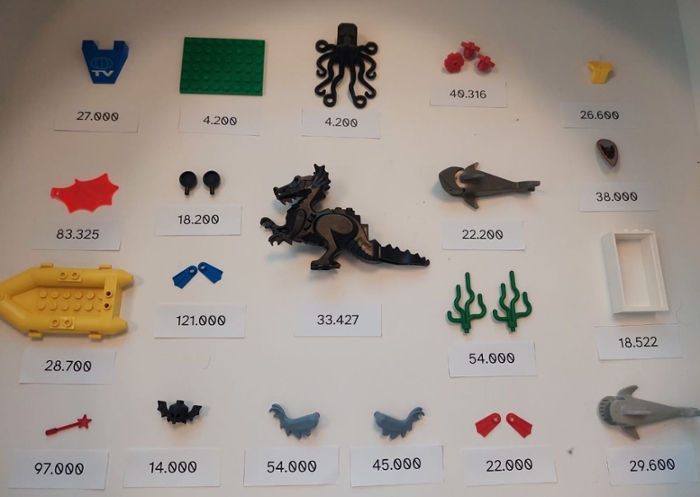
Lego Lost at Sea: an archaeological and environmental exhibition at the Van Steenis
image: Tracey Williams
At the entrance of the Van Steenis building you may now visit an exhibition on material culture. Unexpectedly, it does not display pottery or tools, but building materials. And recent ones at that! Check out the exhibition on Legos lost at sea, conceived and assembled by PhD candidate Maia Casna. ‘These are modern materials that were catalogued in an archaeological manner.’

Tokio Express
Back in the 90-ties, a large cargo vessel called the Tokio Express lost 62 containers off the coast of Cornwall. ‘Among the things that got lost was a container filled with Lego-sets,’ Casna notes. ‘At the time of the incident, no public records were established, so for a long time the spill went under the radar.’
Lego resurfacing
Yet at some point Lego bricks started to surface. ‘Tracey Williams, a woman living in Cornwall, started finding Lego bricks washing up at the beach next to her house. At some point she connected to other people who were discovering Lego pieces on the beaches of Ireland, the Netherlands, and Belgium. The findings drew more and more attention, until even the Lego company itself got involved.’ Asked for an explanation, Lego cross-referenced the bricks found with the list of bricks in one of the Tokio Express’s containers. ‘The materials found thus could be linked to an historical event. To me this is what archaeology is all about: reconstruction human behaviour and events in the past based on material culture.’

Cataloguing Lego
Here the comparison with archaeology does not stop. ‘Beach combers across the North Sea started to catalogue the Lego bricks they found, taking pictures of the items in situ on the beach. An online archive was constructed, and from that detailed observations of the impact of plastic pollution could be made.’ For example, the Lego bricks seamed to wash up in teams of the same items. ‘Various factors are involved here, from the amount of air in the brick, to the composition of the plastic, as well as the location of the set in the container.’

Plastic pollution
Casna’s idea of creating an exhibition on the topic is also related to the denizens of the Van Steenis building. ‘Since our building hosts archaeologists as well as biologists and environment experts, I felt this topic fits everyone. These Lego bricks lost at sea also have a huge implication on the pollution of the oceans.’

A little cleaner
The exhibition also invites people to play their part in countering pollution. ‘Preparing for the exhibition, I travelled to the beach together with student Mattia to beach comb ourselves, specifically looking for Lego bricks.’ While they did not find any small colored bricks, they did encounter a whole load of other stuff. ‘We came back with a back filled with trash washed up by the sea. While we were a bit disappointed for not finding anything interesting, we did make the beach a little bit cleaner.’ To make cleaning the beach a bit more fun, you may take a beach combing Bingo card! Who knows, you may find one of the illusive green dragons!

Local beach combers
In the process of assembling the materials to exhibit, Casna got in touch with local beach combers, like Wim Kruiswijk. ‘It was eye-opening to get in touch with these people. Some of them already have 40 years of experience, and they have seen the pollution in the sea change, noticing changing environmental laws, for example. Though the change is certainly not enough.’
Student Mattia looks back upon a great experience. ‘Working on the exhibition has been exciting. The most interesting part for me was learning more about the practice of beachcombing, its cultural aspect and of how it has radically changed in last few decades. I am really thankful to Maia for involving me in the project.’
Visit the exhibition
The exhibition can be found at the round table next to the entrance of the Van Steenis building until February 2025. ‘Visit the exhibition and pick up a Bingo card! And good luck with your own beach combing efforts.’
This exhibition was made with materials borrowed from Tracey Williams, Elia Bona, and Wim Kruiswijk.
